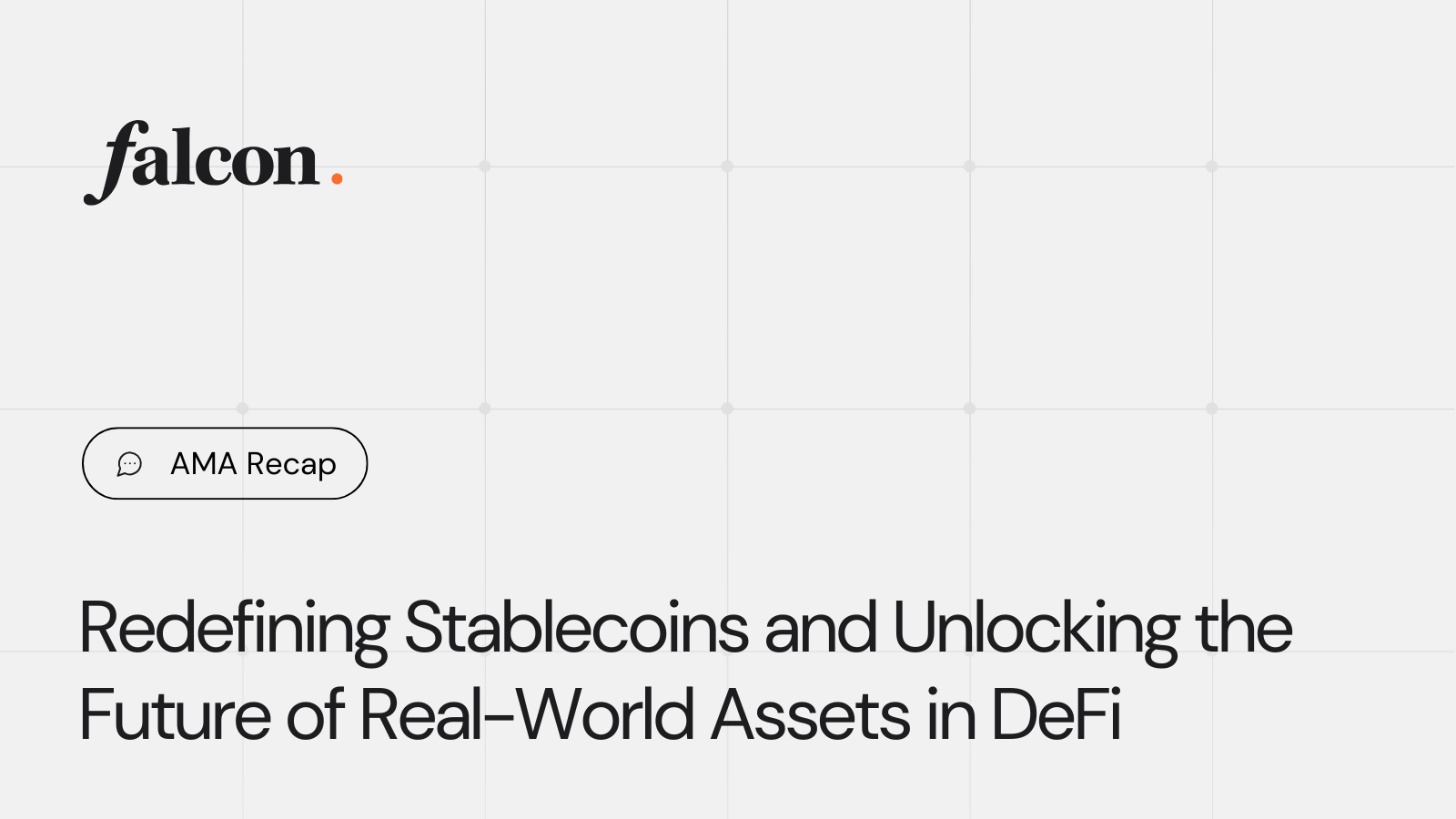AMA Recap: Redefining Stablecoins and Unlocking the Future of Real-World Assets in DeFi
Updated • 15 Aug 2025
Published • 30 Jul 2025
5 mins

In the latest episode of Cryptic Talks, Andrei Grachev, Managing Partner at Falcon, joined the host to discuss one of the most compelling developments in decentralized finance: the convergence of real-world assets and on-chain liquidity. With Falcon’s supply surpassing $1.1 billion and total value locked (TVL) reaching $1.2 billion, the conversation offered rare insight into how a new generation of stablecoin infrastructure is being designed—not just for DeFi natives, but for traditional institutions seeking safe, scalable access to crypto-native yield.
From the onset, Grachev made it clear that Falcon’s ambition goes well beyond issuing another dollar-pegged token. At the heart of Falcon’s ecosystem is USDf, a synthetic dollar that can be minted against a broad range of collateral, including Bitcoin, Ethereum, tokenized stocks, and even U.S. Treasuries. The aim is to allow users to unlock liquidity without selling their underlying assets, bridging the flexibility of DeFi with the stability and yield generation of traditional finance.
What distinguishes Falcon is its ability to make real-world assets economically active. Tokenized treasuries and corporate credit are no longer just representations of value—they’re instruments that can earn yield while being used as collateral to mint USDf. As Grachev explained, many users don't want to sell these assets; they want to deploy them. Falcon allows precisely that, using professional trading strategies like delta-neutral positioning and market arbitrage to put those assets to work without exposing users to unnecessary risk.
This concept of capital efficiency lies at the core of Falcon’s strategy. Unlike traditional DeFi lending protocols, which rely on matching borrowers and lenders and often require over-collateralization without yield, Falcon extracts real value from the assets themselves. When users deposit collateral, they receive not just liquidity in return but also exposure to the yield that Falcon’s trading infrastructure is able to generate. This turns dormant assets into productive collateral, transforming how stablecoins can function in decentralized ecosystems.
Another major advantage Falcon brings to the table is composability. Rather than isolating assets within siloed platforms, Falcon acts as a universal collateral coordination layer. This architecture enables integration across a range of DeFi applications—from lending markets to DAOs and fintech interfaces—allowing other protocols to tap into the same asset pool with consistent risk parameters and shared liquidity. By doing so, Falcon introduces the kind of sophistication and interoperability previously seen only in institutional repo markets, but now executed with the transparency of smart contracts.
Yield generation within Falcon is not just sustainable—it’s actively managed and diversified. Grachev detailed how the protocol uses advanced strategies such as basis trading, perpetual-spot arbitrage, and staking altcoins while maintaining hedged exposure. These mechanisms, long used by traditional trading desks, are now being brought into DeFi in a structured, transparent, and user-accessible manner. The result is a system that consistently delivers stable returns, including a reported 12.7% APY over the last seven days.
Partnerships have played a crucial role in Falcon’s rapid ascent. Collaborations with platforms like Pendle and Morpho have embedded USDf deeply into the DeFi fabric. These integrations enable users to speculate on future APYs, perform leveraged minting strategies, and increase overall protocol utility. Importantly, Falcon doesn’t treat these relationships as simple plug-ins—they are strategic distribution channels that expand reach, liquidity, and confidence in the stablecoin’s utility.
When asked about incentives, Grachev explained Falcon’s use of retroactive rewards and yield multipliers to align with long-term user behavior. Unlike protocols that attract capital with short-term farming incentives, Falcon rewards those who commit to the ecosystem’s growth over time. This approach helps foster a more stable and loyal user base, which is essential as the protocol scales to larger institutional volumes.
Looking ahead, Falcon Finance is prioritizing the addition of corporate credit, emerging market debt, and tokenized private credit to its collateral base. These instruments are already widely traded, ranked, and yield-generating in traditional markets, but have seen limited use in DeFi. By tokenizing and integrating them, Falcon offers a compelling combination of quality, liquidity, and return, while also giving users an additional layer of diversification beyond crypto-native assets. Grachev emphasized that Falcon Finance is not waiting for these markets to mature—it intends to be the protocol that sets the standard and captures the flow early.
Transparency and compliance were also central themes in the conversation. Falcon Finance plans to publish a full list of its underlying assets and is actively working with global legal firms like White & Case to ensure that its operations meet institutional standards. The protocol is undergoing multiple third-party audits, with a second auditor expected to be onboarded soon. These moves are designed to reassure users—especially institutions—that USDf is not just another DeFi experiment but a secure and transparent financial product.
Grachev’s outlook for the protocol is bold yet grounded. He expressed confidence in reaching $5 to $6 billion in supply of the USDf token by the end of the year, and $10 billion by 2026. Rather than relying on speculative growth, Falcon is focused on product rollout, user education, and ecosystem integration. With new infrastructure launching in the coming months, including a more robust transparency portal and audit framework, Falcon is laying the groundwork for what could become one of the most significant capital layers in decentralized finance.
In closing, the host remarked on the rare combination of ambition and responsibility that defines Falcon’s approach. Grachev echoed the sentiment, encouraging users to follow Falcon’s development closely and to participate with feedback as the protocol evolves. The vision is not just to build another DeFi platform, but to create a new financial primitive—one that merges the best of crypto and traditional markets into a single, scalable, and composable system.
Falcon Finance is not only redefining the stablecoin—it's reimagining how capital itself should move in the decentralized era.